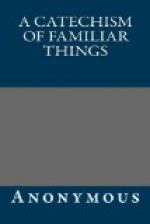The berries are roasted in a revolving metallic cylinder, till they are of a deep brown color, and then ground to powder, and boiled.
Metallic, consisting of metal.
What is Chocolate?
A kind of cake or paste, made of the kernel of the cacao-nut.
Describe the Cacao-nut Tree.
It resembles the cherry tree, and grows to the height of fifteen or sixteen feet. The cacao-nut tree bears leaves, flowers, and fruit, all the year through.
Where does it grow?
In tropical regions, where it is largely cultivated.
Of what form is the fruit?
It is somewhat like a cucumber, about three inches round, and of a yellowish red color. It contains from ten to forty seeds, each covered with a little rind, of a violet color; when this is stripped off, the kernel, of which they make the chocolate, is visible.
How do they make it into a drink?
By boiling it with water or milk. There are various newly-invented ways of preparing chocolate, so that it may be made in a few minutes, by only pouring boiling water upon it.
CHAPTER III.
CALICO, COTTON, CLOTH, WOOL, BAIZE, LINEN, FLAX, HEMP, DIAPER, HOLLAND, CANVAS, AND FLANNEL.
What is Calico?
A kind of printed cotton cloth, of different colors.
From what place did it take its name?
From Calicut, a city on the coast of Malabar, where it was first made; much is now manufactured in the United States, England, and many other countries.
What is Cotton?
A downy or woolly substance, enclosed in the pod, or seed-vessel, of the cotton-plant. The commercial classification of cotton is determined—1, by cleanliness or freedom from sand, dry leaf, and other impurities; 2, by absence of color; both subject also to character of staple, length, and strength and fineness of fibre. These together determine relative value. There are two general classifications, long-stapled and short-stapled. Of the former the best is the sea island cotton of the United States. The short staple cotton, grows in the middle and upper country; the long staple is cultivated in the lower country near the sea, and on the islands near the coasts.
How is it cultivated?
The seeds are sown in ridges made with the plough or hoe; when the plants are mature, the pods open, and the cotton is picked from them.
Where did Cotton anciently grow, and for what was it used?
In Egypt, where it was used by the priests and sacrificers, for a very singular kind of garment worn by them alone.
In what manufacture is it now used?
It is woven into muslins, dimities, cloths, calicoes, &c.; and is also joined with silks and flax, in the composition of other stuffs, and in working with the needle.
How is the Cotton separated from the seed?




